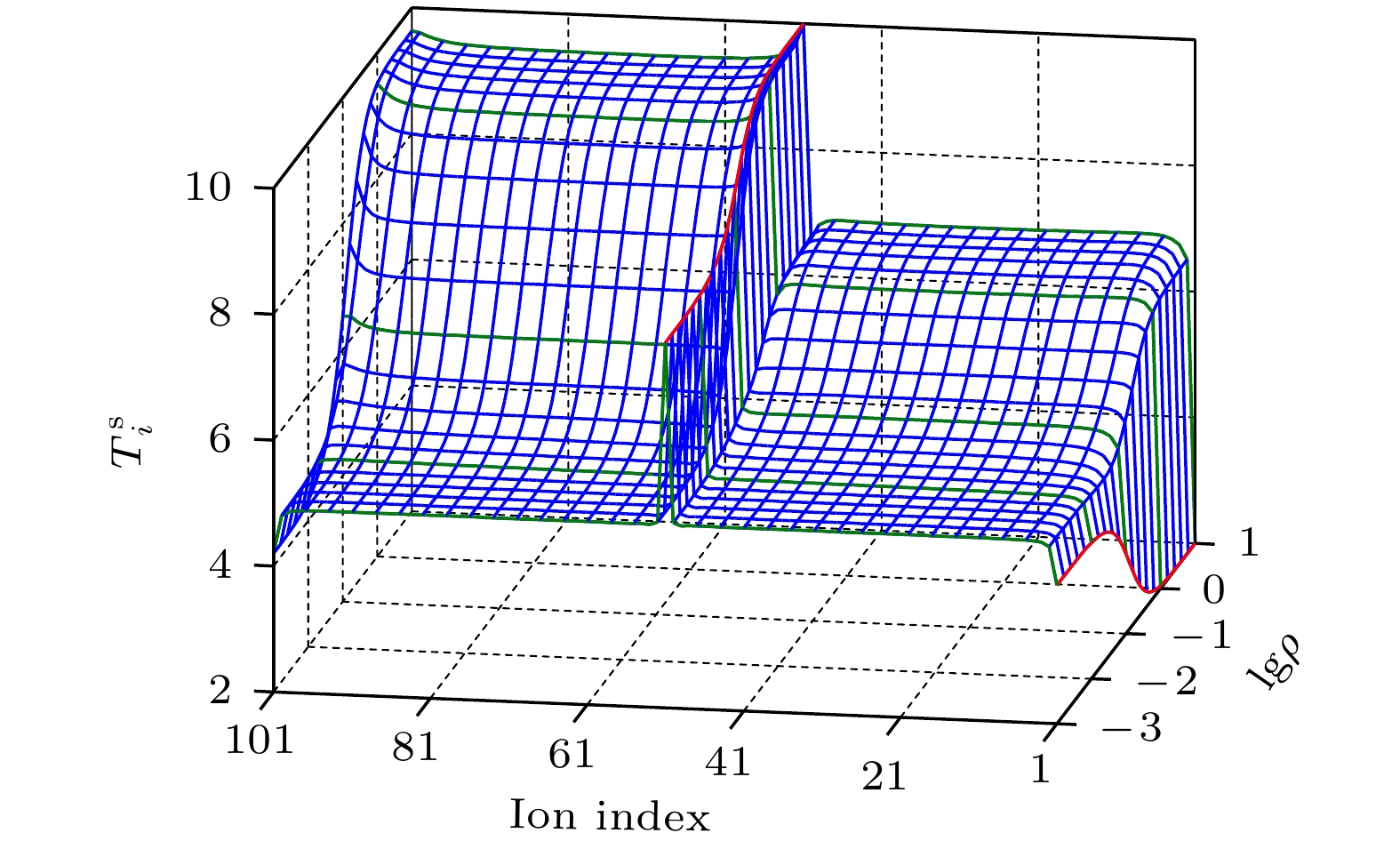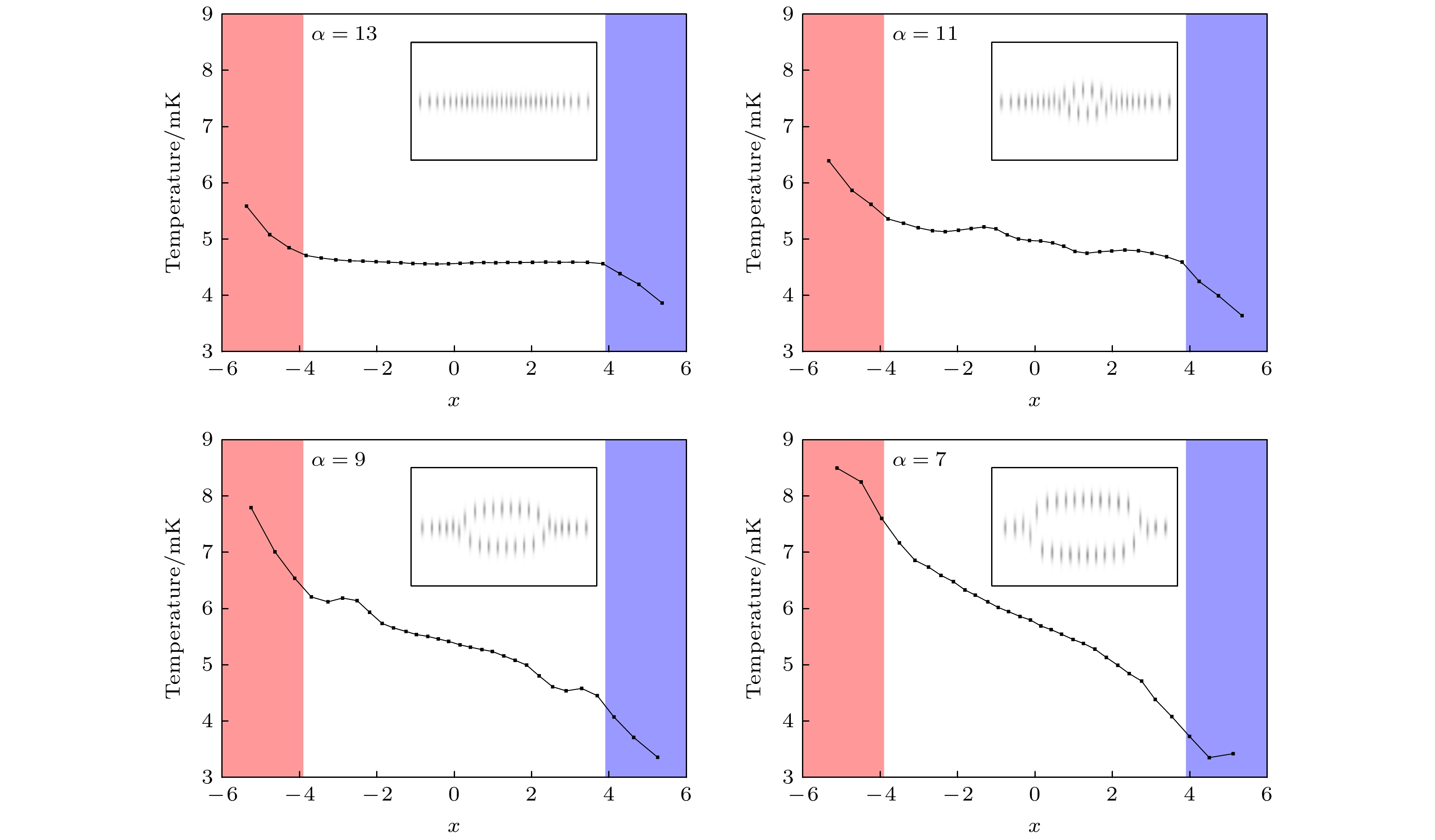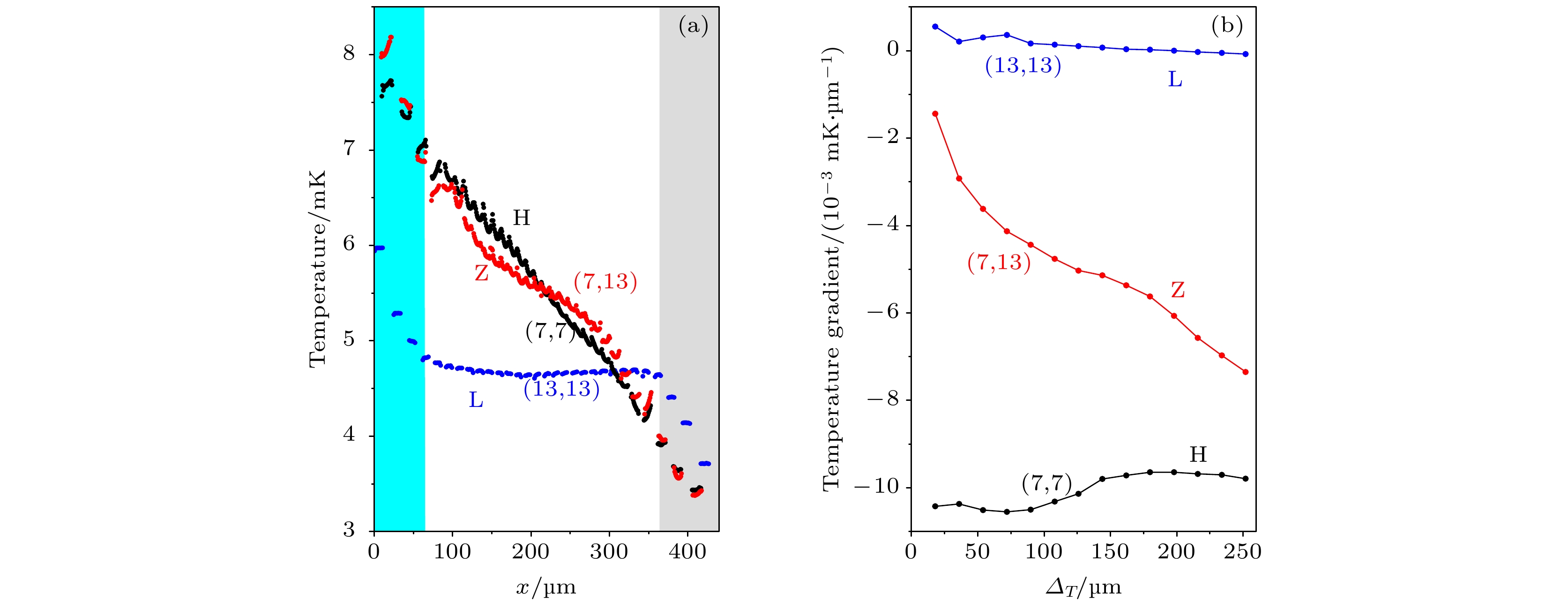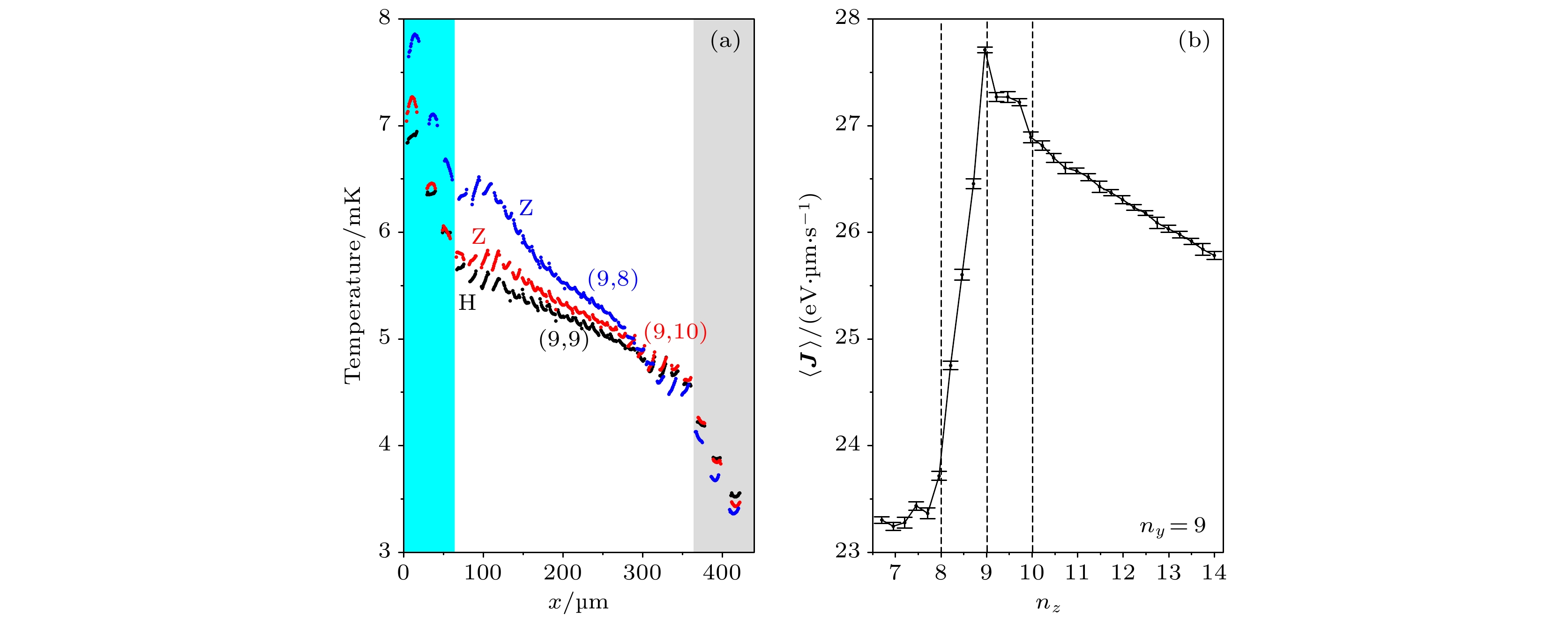-
Heat transport is one of the most important research topics in physics. Especially in recent years, with the in depth study on single-molecule devices, heat transport in low-dimensional (i.e. one- and two-dimensional) microsystems has received more and more attention. In the research of Fermi-Pasta-Ulam crystals and harmonic crystals, it is widely accepted that heat conduction in low-dimensional system does not follow Fourier’s law. Due to the lack of the equipment that can directly measure heat current, it has been proven to be a challenging task to carry out relevant experiments. Ion crystal in ion trap is located in vacuum and does not exchange energy with the external environment. The crystal structure and temperature can be accurately controlled by electric field and optical field, providing an ideal experimental platform for studying thermal conduction in low-dimensional crystals in classical state or quantum state. Herein we summarize the recent theoretical research on thermal conduction in ion crystals, including the methods of calculating temperature distribution and steady-state heat current in one-dimensional, two-dimensional, and three-dimensional models, as well as the characteristics of heat current and temperature distribution under different ion crystal configurations. Because the nonlinear effect caused by the imbalance among three dimensions hinders the heat transport, the heat current in ion crystal is largest in the linear configuration while smallest in the zig-zag configuration. In addition, we also introduce the influence of disorder on the thermal conductivity of ion crystal, including the influence on the heat current across various ion crystal configurations such as the linear, the zig-zag and the helical configuration. Notably, the susceptibility of ion crystal to disorder increases with crystal size increasing. Specifically, the zig-zag ion crystal configuration exhibits the largest susceptibility to disorder, whereas the linear configuration is least affected. Finally, we provide a concise overview of experimental studies of the heat conduction in low-dimensional systems. Examination of the heat conduction in ion crystal offers a valuable insight into various cooling techniques employed in ion trap systems, including sympathetic cooling, electromagnetically induced transparency cooling, and polarization gradient cooling. Just like macroscopic thermal diodes made by thermal metamaterials, it is possible that the microscopic thermal diodes can also be made in low-dimensional systems.
-
Keywords:
- ion trap /
- ion crystals /
- heat transport /
- structural phase transition
[1] Li B, Wang L, Hu B 2002 Phys. Rev. Lett. 88 223901
 Google Scholar
Google Scholar
[2] Dhar A, Roy D 2006 J. Stat. Phys. 125 801
 Google Scholar
Google Scholar
[3] Dhar A 2008 Adv. Phys. 57 457
 Google Scholar
Google Scholar
[4] Rieder Z, Lebowitz J L, Lieb E 1967 J. Math. Phys. 8 1073
 Google Scholar
Google Scholar
[5] Dhar A, Dandekar R 2015 Physica A 418 49
 Google Scholar
Google Scholar
[6] Chaudhuri A, Kundu A, Roy D, Dhar A, Lebowitz J L, Spohn H 2010 Phys. Rev. B 81 064301
[7] Saito K, Dhar A 2010 Phys. Rev. Lett. 104 040601
 Google Scholar
Google Scholar
[8] Dhar A 2001 Phys. Rev. Lett. 86 5882
 Google Scholar
Google Scholar
[9] Casher A, Lebowitz J L 1971 J. Math. Phys. 12 1701
 Google Scholar
Google Scholar
[10] Rich M, Visscher W M 1975 Phys. Rev. B 11 2164
 Google Scholar
Google Scholar
[11] Rubin R J, Greer W L 1971 J. Math. Phys. 12 1686
 Google Scholar
Google Scholar
[12] Verheggen T 1979 Commun. Math. Phys. 68 69
 Google Scholar
Google Scholar
[13] Hu B, Li B, Zhao H 2000 Phys. Rev. E 61 3828
 Google Scholar
Google Scholar
[14] Wang P, Luan C Y, Qiao M, Um M, Zhang J, Wang Y, Yuan X, Gu M, Zhang J, Kim K 2021 Nat. Commun. 12 233
 Google Scholar
Google Scholar
[15] Kielpinski D, Monroe C, Wineland D J 2002 Nature 417 709
 Google Scholar
Google Scholar
[16] Leibfried D, Blatt R, Monroe C, Wineland D 2003 Rev. Mod. Phys. 75 281
 Google Scholar
Google Scholar
[17] Schiffer J P 1993 Phys. Rev. Lett. 70 818
 Google Scholar
Google Scholar
[18] Eckmann J P, Pillet C A, Rey-Bellet L 1999 Commun. Math. Phys. 201 657
 Google Scholar
Google Scholar
[19] Ford G W, Kac M, Mazur P 1965 J. Math. Phys. 6 504
 Google Scholar
Google Scholar
[20] Zürcher U, Talkner P 1990 Phys. Rev. A 42 3278
 Google Scholar
Google Scholar
[21] Saito K, Takesue S, Miyashita S 2000 Phys. Rev. E 61 2397
 Google Scholar
Google Scholar
[22] Dhar A, Shastry B S 2003 Phys. Rev. B 67 195405
 Google Scholar
Google Scholar
[23] Segal D, Nitzan A, Hänggi P 2003 J. Chem. Phys. 119 6840
 Google Scholar
Google Scholar
[24] Lepri S, Livi R, Politi A 2003 Phys. Rep. 377 1
 Google Scholar
Google Scholar
[25] Lin G D, Duan L M 2011 New J. Phys. 13 075015
 Google Scholar
Google Scholar
[26] Ruiz A, Alonso D, Plenio M B, del Campo A 2014 Phys. Rev. B 89 214305
 Google Scholar
Google Scholar
[27] Freitas N, Martinez E A, Paz J P 2016 Phys. Scr. 91 013007
 Google Scholar
Google Scholar
[28] Ruiz-García A, Fernández J J, Alonso D 2019 Phys. Rev. E 99 062105
[29] Gardiner C, Zoller P 2010 Quantum Noise: A Handbook and Non-Markovian Quantum Stochastic Methods with Applications to Quantum Optics (3rd Ed.) (Berlin: Springer) pp42−89
[30] Walls D F, Milburn G J 2010 Quantum Optics (2nd Ed.) (Berlin: Springer) pp112−117
[31] Novikov E A 1965 Sov. Phys. JETP 20 1290
[32] Plenio M B, Huelga S F 2008 New J. Phys. 10 113019
 Google Scholar
Google Scholar
[33] Kubo R 1966 Rep. Prog. Phys. 29 255
 Google Scholar
Google Scholar
[34] Piccirelli R A 1968 Phys. Rev. 175 77
 Google Scholar
Google Scholar
[35] Martinez E A, Paz J P 2013 Phys. Rev. Lett. 110 130406
 Google Scholar
Google Scholar
[36] Freitas N, Paz J P 2014 Phys. Rev. E 90 042128
 Google Scholar
Google Scholar
[37] Freitas N, Paz J P 2014 Phys. Rev. E 90 069903
 Google Scholar
Google Scholar
[38] Tisseur F, Meerbergen K 2001 SIAM Rev. 43 235
 Google Scholar
Google Scholar
[39] Li B, Zhao H, Hu B 2001 Phys. Rev. Lett. 86 63
 Google Scholar
Google Scholar
[40] Birkl G, Kassner S, Walther H 1992 Nature 357 310
 Google Scholar
Google Scholar
[41] Dubin D H E, O’Neil T M 1999 Rev. Mod. Phys. 71 87
 Google Scholar
Google Scholar
[42] Pyka K, Keller J, Partner H L, Nigmatullin R, Burgermeister T, Meier D M, Kuhlmann K, Retzker A, Plenio M B, Zurek W H, del Campo A, Mehlstäubler T E 2013 Nat. Commun. 4 2291
 Google Scholar
Google Scholar
[43] Yan L L, Wan W, Chen L, Zhou F, Gong S J, Tong X, Feng M 2016 Sci. Rep. 6 21547
 Google Scholar
Google Scholar
[44] Li J, Yan L L, Chen L, Liu Z C, Zhou F, Zhang J Q, Yang W L, Feng M 2019 Phys. Rev. A 99 063402
 Google Scholar
Google Scholar
[45] Liu Z C, Chen L, Li J, Zhang H, Li C B, Zhou F, Su S L, Yan L L, Feng M 2020 Phys. Rev. A 102 033116
 Google Scholar
Google Scholar
[46] Srivathsan B, Fischer M, Alber L, Weber M, Sondermann M, Leuchs G 2019 New J. Phys. 21 113014
 Google Scholar
Google Scholar
[47] Ramm M, Pruttivarasin T, Häffner H 2014 New J. Phys. 16 063062
 Google Scholar
Google Scholar
[48] Mao Z C, Xu Y Z, Mei Q X, Zhao W D, Jiang Y, Cheng Z J, Chang X Y, He L, Yao L, Zhou Z C, Wu Y K, Duan L M 2022 Phys. Rev. A 105 033107
 Google Scholar
Google Scholar
[49] Zuo Y N, Han J Z, Zhang J W, Wang L J 2019 Appl. Phys. Lett. 115 061103
 Google Scholar
Google Scholar
[50] Li M, Zhang Y, Zhang Q Y, Bai W L, He S G, Peng W C, Tong X 2023 Chin. Phys. B 32 036402
 Google Scholar
Google Scholar
[51] Qiao M, Wang Y, Cai Z, Du B, Wang P, Luan C, Chen W, Noh H R, Kim K 2021 Phys. Rev. Lett. 126 023604
 Google Scholar
Google Scholar
[52] Joshi M K, Fabre A, Maier C, Brydges T, Kiesenhofer D, Hainzer H, Blatt R, Roos C F 2020 New J. Phys. 22 103013
 Google Scholar
Google Scholar
[53] Tighe T S, Worlock J M, Roukes M L 1997 Appl. Phys. Lett. 70 2687
 Google Scholar
Google Scholar
[54] Kim P, Shi L, Majumdar A, McEuen P L 2001 Phys. Rev. Lett. 87 215502
 Google Scholar
Google Scholar
[55] Chang C W, Okawa D, Majumdar A, Zettl A 2006 Science 314 1121
 Google Scholar
Google Scholar
[56] Simón M A, Martínez-Garaot S, Pons M, Muga J G 2019 Phys. Rev. E 100 032109
-
图 1 $ \rho $值不同时, 由100个离子组成的离子晶体在稳态下的温度分布[25], 其中离子的温度$ T_{i}^{{\mathrm{s}}} $由平均声子数来表示. 第1个离子和第100个离子与热库相接触, 由图中的红线表示, 其他的离子由蓝线表示
Figure 1. Temperature distribution of an ion crystal composed of 100 ions under different $ \rho $ in stable state, where temperature distribution $ T_{i}^{{\mathrm{s}}} $ measured by the mean thermal phonon number. The 1st and the 100th ions are in contact with the thermal bath, indicated by the red line in the figure, while other ions are indicated by the blue line. The figure is taken from Ref. [25].
图 2 由$ 101 $个离子组成的离子晶体在稳态下的温度分布[25], 其中离子的温度$ T_{i}^{{\mathrm{s}}} $由平均声子数来表示. 第1个离子和第$ 51 $个离子与热库相接触. 与热库相接触的离子由图中的红线表示, 其他的离子由蓝线表示
Figure 2. Temperature distribution of an ion crystal composed of 101 ions under different $ \rho $ in stable state, where temperature distribution $ T_{i}^{{\mathrm{s}}} $ measured by the mean thermal phonon number. The first ion and the $ 51{\mathrm{st }}$ ion are in contact with the thermal bath. Ions in contact with the thermal bath are indicated by the red line in the figure, while other ions are indicated by the blue line. The figure is taken from Ref. [25].
图 3 处于不同构型下的离子晶体在x方向上的温度分布 [26], 其中$ \alpha $表示结构相变的序参量. 两个颜色不同的区域中的离子和不同参数的激光相互作用. 插图表示离子晶体的构型
Figure 3. Temperature distribution of ion crystals vs. the distance x in different configurations, where $ \alpha $ represents the order parameter of structural phase transition, and the two regions with different colors represent ions interacting with the laser. The insets show the configurations of ion crystals. The figure is taken from Ref. [26].
图 5 在不同$ n_{y} $和$ n_{z} $的取值下, 离子晶体结构相变的相图[28]. 用L (linear), Z (zigzag)和H (helical)这三个字母代表离子晶体的直线构型、之字构型和螺旋构型. 沿HL线, $ (n_{y}, n_{z}) $值的变化会产生直线构型和螺旋构型之间的结构相变. 沿ZL线, $ (n_{y}, n_{z}) $值的变化会产生直线构型与之字构型之间的结构相变. 沿ZHZ线, $ (n_{y}, n_{z}) $值的变化会产生从之字构型到螺旋构型再到之字构型的结构相变. 图中的灰色区域代表直线构型. 在灰色区域之外, HL线之上的区域代表处于$ x{\text{-}}y $平面上的之字构型, 在HL线之下的区域代表处于x -z平面上的之字构型, HL线上为螺旋构型
Figure 5. Phase diagram of ion crystal structural phase transitions under different values of $ n_{y} $ and $ n_{z} $. L (linear), Z (zigzag), and H (helical) represent the linear, zigzag, and helical configurations of ion crystal. ZL line, HL line and ZHZ line represent the zigzag-linear transition, helical-linear transition and zigzag-helical-zigzag transition. The gray region in the figure represents the linear configuration. Outside of the gray region, the region above the HL line represents the zigzag configuration lying in the $ x{\text{-}}y $ plane, while the region below the HL line represents the zigzag configuration lying in the $ x{\text{-}}z $ plane. The region on the HL line represents the helical configuration. The figure is taken from Ref. [28]
图 6 在离子数$ N=30 $的离子晶体中, 不同构型的离子晶体的稳态温度分布[28], 图中L代表直线构型、Z代表之字构型、H代表螺旋构型, 图中的参数为$ (n_{y}, n_{z}) $ (a) 3种不同构型的离子晶体在稳态下的温度分布, 两个颜色不同的区域中的离子和不同参数的激光相互作用; (b)在稳态下, 3种不同构型的离子晶体不与激光接触的部分的温度梯度分布, 其中$\varDelta_{\rm T} $代表与系统中心的距离
Figure 6. Temperature distribution of ion crystals with 30 ions with different configurations in stable state, where L represents linear configuration, Z represents zigzag configuration, and H represents helical configuration. The labels indicate the values of $ (n_{y}, n_{z}) $: (a) Temperature distribution of three different configurations of ion crystals in stable state, where two different colors represent ions interacting with the laser; (b) distribution of temperature gradients in the parts of ion crystals with three different configurations that are not in contact with the laser in stable state, where $ \varDelta_{\rm T} $represents the distance from the center of the system. The figure is taken from Ref. [28].
图 7 在离子数$ N=30 $的离子晶体中, 离子晶体从处于x-z平面的之字构型相变到螺旋构型再相变到处于x-y平面的之字构型的过程中的温度分布和热流变化[28] (a)离子晶体在结构相变过程中的3种典型的温度分布, 两个颜色不同的区域中的离子和不同参数的激光相互作用, 图中Z代表之字构型, H代表螺旋构型, 图中的参数为$ (n_{y}, n_{z}) $; (b)在$ n_{y} $保存不变时, $ n_{z} $不断增大的过程中的热流变化
Figure 7. Temperature distribution and heat flux changes in an ion crystal with 30 ions during the process of zigzag-helical-zigzag transition where Z represents zigzag configuration and H represents helical configuration: (a) Three typical temperature distributions of the ion crystal during the structural phase transition process, where two different colors represent ions interacting with the laser; the labels indicate the values of $ (n_{y}, n_{z}) $; (b) changes in heat flux during the process of increasing $ n_{z} $ while keeping $ n_{y} $ constant. The figure is taken from Ref. [28].
-
[1] Li B, Wang L, Hu B 2002 Phys. Rev. Lett. 88 223901
 Google Scholar
Google Scholar
[2] Dhar A, Roy D 2006 J. Stat. Phys. 125 801
 Google Scholar
Google Scholar
[3] Dhar A 2008 Adv. Phys. 57 457
 Google Scholar
Google Scholar
[4] Rieder Z, Lebowitz J L, Lieb E 1967 J. Math. Phys. 8 1073
 Google Scholar
Google Scholar
[5] Dhar A, Dandekar R 2015 Physica A 418 49
 Google Scholar
Google Scholar
[6] Chaudhuri A, Kundu A, Roy D, Dhar A, Lebowitz J L, Spohn H 2010 Phys. Rev. B 81 064301
[7] Saito K, Dhar A 2010 Phys. Rev. Lett. 104 040601
 Google Scholar
Google Scholar
[8] Dhar A 2001 Phys. Rev. Lett. 86 5882
 Google Scholar
Google Scholar
[9] Casher A, Lebowitz J L 1971 J. Math. Phys. 12 1701
 Google Scholar
Google Scholar
[10] Rich M, Visscher W M 1975 Phys. Rev. B 11 2164
 Google Scholar
Google Scholar
[11] Rubin R J, Greer W L 1971 J. Math. Phys. 12 1686
 Google Scholar
Google Scholar
[12] Verheggen T 1979 Commun. Math. Phys. 68 69
 Google Scholar
Google Scholar
[13] Hu B, Li B, Zhao H 2000 Phys. Rev. E 61 3828
 Google Scholar
Google Scholar
[14] Wang P, Luan C Y, Qiao M, Um M, Zhang J, Wang Y, Yuan X, Gu M, Zhang J, Kim K 2021 Nat. Commun. 12 233
 Google Scholar
Google Scholar
[15] Kielpinski D, Monroe C, Wineland D J 2002 Nature 417 709
 Google Scholar
Google Scholar
[16] Leibfried D, Blatt R, Monroe C, Wineland D 2003 Rev. Mod. Phys. 75 281
 Google Scholar
Google Scholar
[17] Schiffer J P 1993 Phys. Rev. Lett. 70 818
 Google Scholar
Google Scholar
[18] Eckmann J P, Pillet C A, Rey-Bellet L 1999 Commun. Math. Phys. 201 657
 Google Scholar
Google Scholar
[19] Ford G W, Kac M, Mazur P 1965 J. Math. Phys. 6 504
 Google Scholar
Google Scholar
[20] Zürcher U, Talkner P 1990 Phys. Rev. A 42 3278
 Google Scholar
Google Scholar
[21] Saito K, Takesue S, Miyashita S 2000 Phys. Rev. E 61 2397
 Google Scholar
Google Scholar
[22] Dhar A, Shastry B S 2003 Phys. Rev. B 67 195405
 Google Scholar
Google Scholar
[23] Segal D, Nitzan A, Hänggi P 2003 J. Chem. Phys. 119 6840
 Google Scholar
Google Scholar
[24] Lepri S, Livi R, Politi A 2003 Phys. Rep. 377 1
 Google Scholar
Google Scholar
[25] Lin G D, Duan L M 2011 New J. Phys. 13 075015
 Google Scholar
Google Scholar
[26] Ruiz A, Alonso D, Plenio M B, del Campo A 2014 Phys. Rev. B 89 214305
 Google Scholar
Google Scholar
[27] Freitas N, Martinez E A, Paz J P 2016 Phys. Scr. 91 013007
 Google Scholar
Google Scholar
[28] Ruiz-García A, Fernández J J, Alonso D 2019 Phys. Rev. E 99 062105
[29] Gardiner C, Zoller P 2010 Quantum Noise: A Handbook and Non-Markovian Quantum Stochastic Methods with Applications to Quantum Optics (3rd Ed.) (Berlin: Springer) pp42−89
[30] Walls D F, Milburn G J 2010 Quantum Optics (2nd Ed.) (Berlin: Springer) pp112−117
[31] Novikov E A 1965 Sov. Phys. JETP 20 1290
[32] Plenio M B, Huelga S F 2008 New J. Phys. 10 113019
 Google Scholar
Google Scholar
[33] Kubo R 1966 Rep. Prog. Phys. 29 255
 Google Scholar
Google Scholar
[34] Piccirelli R A 1968 Phys. Rev. 175 77
 Google Scholar
Google Scholar
[35] Martinez E A, Paz J P 2013 Phys. Rev. Lett. 110 130406
 Google Scholar
Google Scholar
[36] Freitas N, Paz J P 2014 Phys. Rev. E 90 042128
 Google Scholar
Google Scholar
[37] Freitas N, Paz J P 2014 Phys. Rev. E 90 069903
 Google Scholar
Google Scholar
[38] Tisseur F, Meerbergen K 2001 SIAM Rev. 43 235
 Google Scholar
Google Scholar
[39] Li B, Zhao H, Hu B 2001 Phys. Rev. Lett. 86 63
 Google Scholar
Google Scholar
[40] Birkl G, Kassner S, Walther H 1992 Nature 357 310
 Google Scholar
Google Scholar
[41] Dubin D H E, O’Neil T M 1999 Rev. Mod. Phys. 71 87
 Google Scholar
Google Scholar
[42] Pyka K, Keller J, Partner H L, Nigmatullin R, Burgermeister T, Meier D M, Kuhlmann K, Retzker A, Plenio M B, Zurek W H, del Campo A, Mehlstäubler T E 2013 Nat. Commun. 4 2291
 Google Scholar
Google Scholar
[43] Yan L L, Wan W, Chen L, Zhou F, Gong S J, Tong X, Feng M 2016 Sci. Rep. 6 21547
 Google Scholar
Google Scholar
[44] Li J, Yan L L, Chen L, Liu Z C, Zhou F, Zhang J Q, Yang W L, Feng M 2019 Phys. Rev. A 99 063402
 Google Scholar
Google Scholar
[45] Liu Z C, Chen L, Li J, Zhang H, Li C B, Zhou F, Su S L, Yan L L, Feng M 2020 Phys. Rev. A 102 033116
 Google Scholar
Google Scholar
[46] Srivathsan B, Fischer M, Alber L, Weber M, Sondermann M, Leuchs G 2019 New J. Phys. 21 113014
 Google Scholar
Google Scholar
[47] Ramm M, Pruttivarasin T, Häffner H 2014 New J. Phys. 16 063062
 Google Scholar
Google Scholar
[48] Mao Z C, Xu Y Z, Mei Q X, Zhao W D, Jiang Y, Cheng Z J, Chang X Y, He L, Yao L, Zhou Z C, Wu Y K, Duan L M 2022 Phys. Rev. A 105 033107
 Google Scholar
Google Scholar
[49] Zuo Y N, Han J Z, Zhang J W, Wang L J 2019 Appl. Phys. Lett. 115 061103
 Google Scholar
Google Scholar
[50] Li M, Zhang Y, Zhang Q Y, Bai W L, He S G, Peng W C, Tong X 2023 Chin. Phys. B 32 036402
 Google Scholar
Google Scholar
[51] Qiao M, Wang Y, Cai Z, Du B, Wang P, Luan C, Chen W, Noh H R, Kim K 2021 Phys. Rev. Lett. 126 023604
 Google Scholar
Google Scholar
[52] Joshi M K, Fabre A, Maier C, Brydges T, Kiesenhofer D, Hainzer H, Blatt R, Roos C F 2020 New J. Phys. 22 103013
 Google Scholar
Google Scholar
[53] Tighe T S, Worlock J M, Roukes M L 1997 Appl. Phys. Lett. 70 2687
 Google Scholar
Google Scholar
[54] Kim P, Shi L, Majumdar A, McEuen P L 2001 Phys. Rev. Lett. 87 215502
 Google Scholar
Google Scholar
[55] Chang C W, Okawa D, Majumdar A, Zettl A 2006 Science 314 1121
 Google Scholar
Google Scholar
[56] Simón M A, Martínez-Garaot S, Pons M, Muga J G 2019 Phys. Rev. E 100 032109
Catalog
Metrics
- Abstract views: 5925
- PDF Downloads: 163
- Cited By: 0















 DownLoad:
DownLoad:






